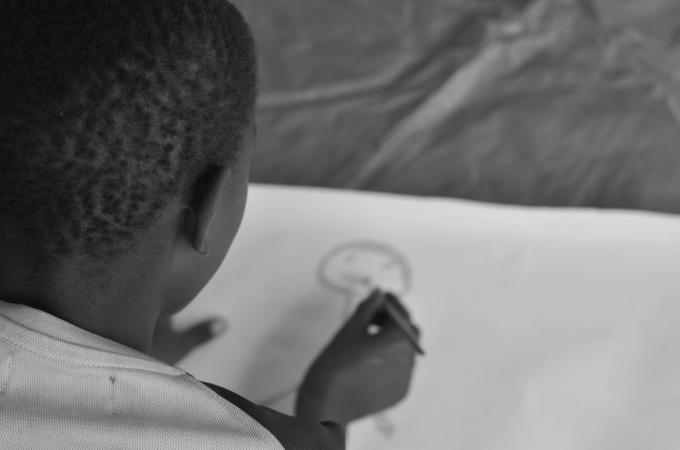Healing and Education Through Arts in Camps
The scale of the disaster in the Lower Shire has wreaked havoc on the densely populated country of Malawi, where most people survive from subsistence farming. Crops of maize have been destroyed, villages obliterated, homes swept away and livestock killed.
Despite the predicament, there are children who have survived to tell their tales. While they crowd in tents in the camps, where there are no comforts as they might have used to enjoy at home, they begin to feel safe in their new families.
At Bitilinyu camp, in Nsanje District, one of the thirteen camps Save the Children works in, once every week a group of 70 primary school learners meet in the afternoon after classes.
Here they meet as one big family. They make a circle while holding hands. They all sing and dance. Drums are heard. The noise and the singing get louder. The excitement grows. It’s time for group therapies.
They are told to go into small groups of five. As they await further instruction, they use the time for discussing this and that. Some ask each other’s names. Here the children share stories and jokes too.
During the group sessions, they are told to draw, on paper, one incident in their lives that makes them very sad - an incident that has left a mark in their lives.

As the learners start drawing, the noise subdues. There is now total silence in this room. Everyone seems to be concentrating on telling their story through arts. Later on, every one, one by one, is asked to explain to the group what they have drawn and what it means.
The process brings mixed feelings. A few girls are seen crying. Some boys also shed tears. They feel like they are one family now and they open up to each other. They have found friends whom they can share their stories with.
Most stories are very common. They draw houses being blown away, rivers swelling, farms and livestock being swept away.
One girl still remembers how she lost her only brother to the floods.
“Every day I live to remember this day – when I witnessed my only brother being swept away by the floods. I was so powerless that even when my brother asked for help, I could do nothing,” she cried.
A few boys narrate how they lost their livestock.
Another young girl, aged five narrates her ordeal.
“This day I was at home when I saw people running everywhere. When I realised what was happening, it was too late to run. So I just climbed a tree close to our house. While in the tree I saw a big snake coming to where I was,” she narrated. Apparently the snake was also seeking refuge in the tree.
These sessions are held once every week by Save the Children Early Childhood Development facilitators in the camps. They are a means through which the children share their experiences and ordeal. Save the Children, being a child-centered organisation, has helped establish and revamp such sessions in almost all the camps.
“The aim is to create an environment where the children feel loved and have friends. They regain their self-esteem and feel as part of a big family,” explained Enala Kamanga, Save the Children’s ECD facilitator in the district.
Written by Collins Mhango, Knowledge Management Officer
This story was also featured in Malawi’s, The Nation Newspaper on 29th April 2015 as part of an overview of Save the Children’s Humanitarian Response between the months of January and April 2015. Click the following like to access it:-
http://www.scribd.com/doc/263517264/Save-the-Children-Pullout-Online
 Malawi
Malawi